

News
SpaceX’s first NASA astronauts to receive Space Medal of Honor for Dragon test flight
NASA says that the astronauts responsible for SpaceX’s first crewed Dragon test flight will be awarded the Congressional Space Medal of Honor for their bravery.
Kamala Harris, the sitting US Vice President and Chair of the National Space Council, will bestow the exceptionally rare awards to former NASA astronauts Douglas Hurley and Robert Behnken in a ceremony on Tuesday, January 31st. NASA will stream the event live on all social media platforms and its own NASA TV service, beginning around 4:15 pm EST (21:15 UTC).
The update that's rolling out to the fleet makes full use of the front and rear steering travel to minimize turning circle. In this case a reduction of 1.6 feet just over the air— Wes (@wmorrill3) April 16, 2024
Since Congress authorized the Congressional Space Medal of Honor in 1969, it has been awarded just 28 times. Just 11 went to living astronauts, while the other 17 were awarded posthumously: to the three NASA astronauts killed in the 1967 Apollo 1 accident and the 14 astronauts killed in the Space Shuttle’s 1986 Challenger disaster and 2003 Columbia disaster. Former President George W. Bush awarded the most recent medal to Robert L. Crippen, the first Space Shuttle pilot, in 2006.
NASA notes that “despite the medal’s name, the President awards this medal based upon recommendations from the NASA Administrator,” indicating that Administrator Bill Nelson selected Behnken and Hurley for the honor. It’s difficult to imagine a pair of astronauts more worthy of ending the 16-year gap since the last Space Medal of Honor was awarded.
Prior to the Dragon test flight they will be honored for, Behnken and Hurley had storied careers in the US military and at NASA. Bob Behnken earned a PhD in mechanical engineering from Caltech in 1997 and eventually became a lead flight test engineer in the US Air Force’s F-22 Raptor program. He was selected as a NASA astronaut candidate in 2000 and flew two Space Shuttle missions in 2008 and 2010. In 2012, Behnken was chosen to lead NASA’s prestigious Astronaut Office, and did so for three years before he began training for the Commercial Crew Program.
Doug Hurley earned a Bachelor’s degree in civil engineering in 1988 and received a commission in the US Marine Corps upon graduating. He made three deployments as an F/A-18 pilot and later became a Navy Test Pilot in 1997. Hurley was “the first Marine pilot to fly the F/A-18 E/F Super Hornet” and has experience flying more than 25 types of aircraft. He was also selected to become an astronaut in 2000 and flew on two Space Shuttle flights, including the Shuttle’s 135th and final mission in 2011.
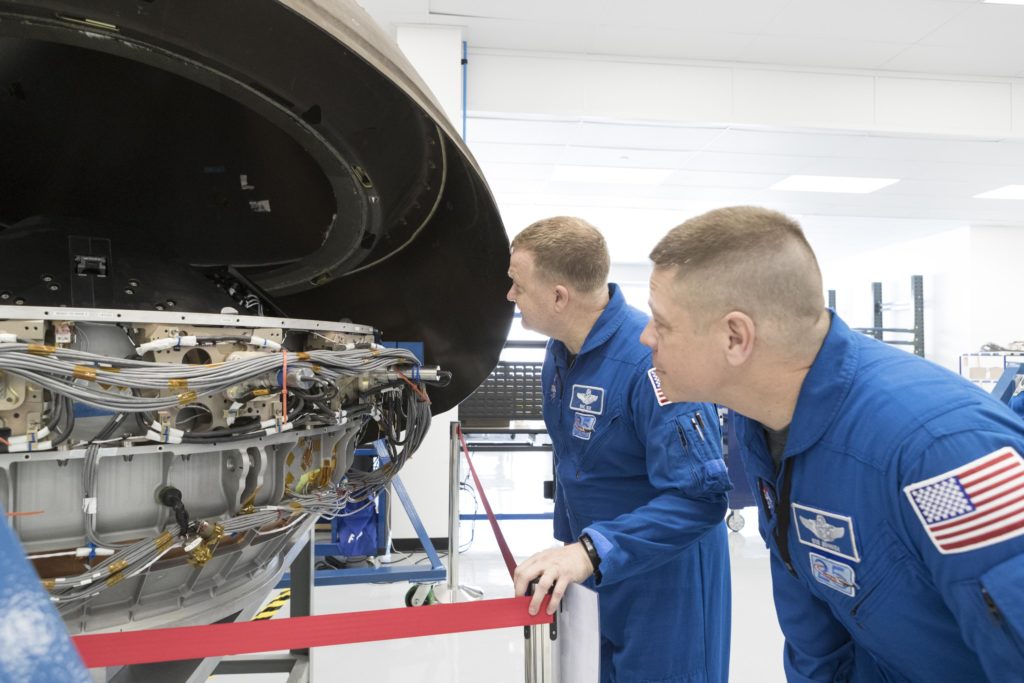
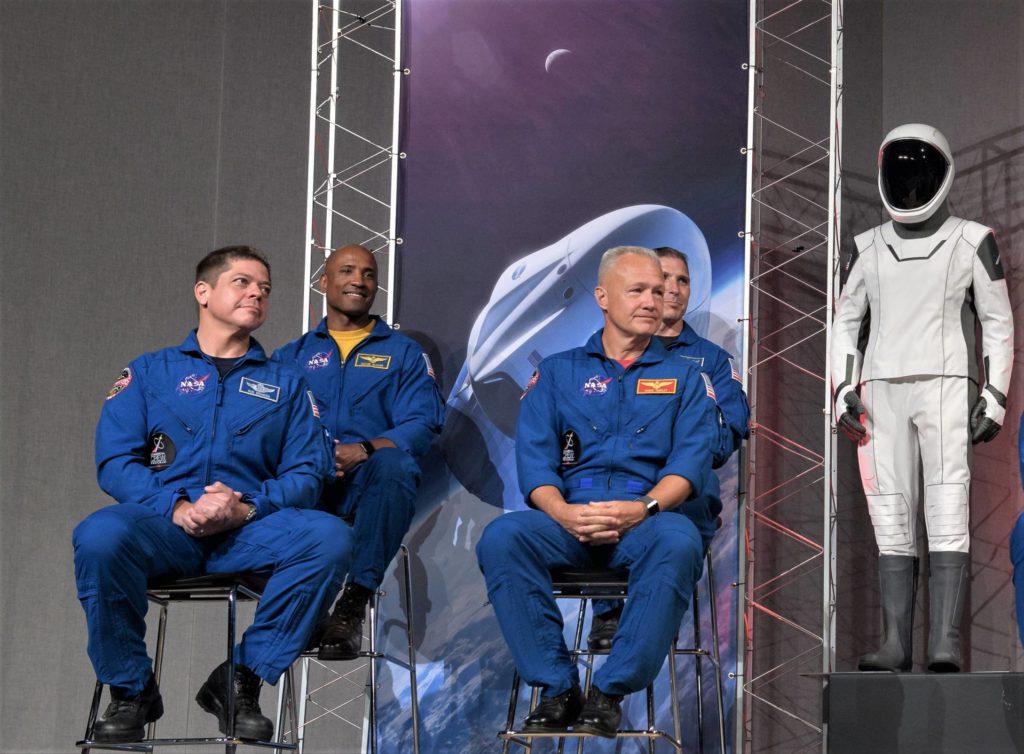
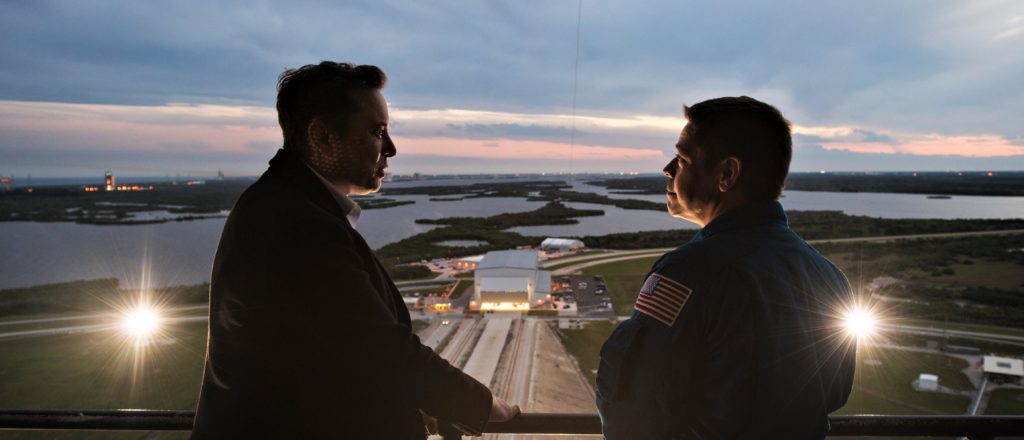

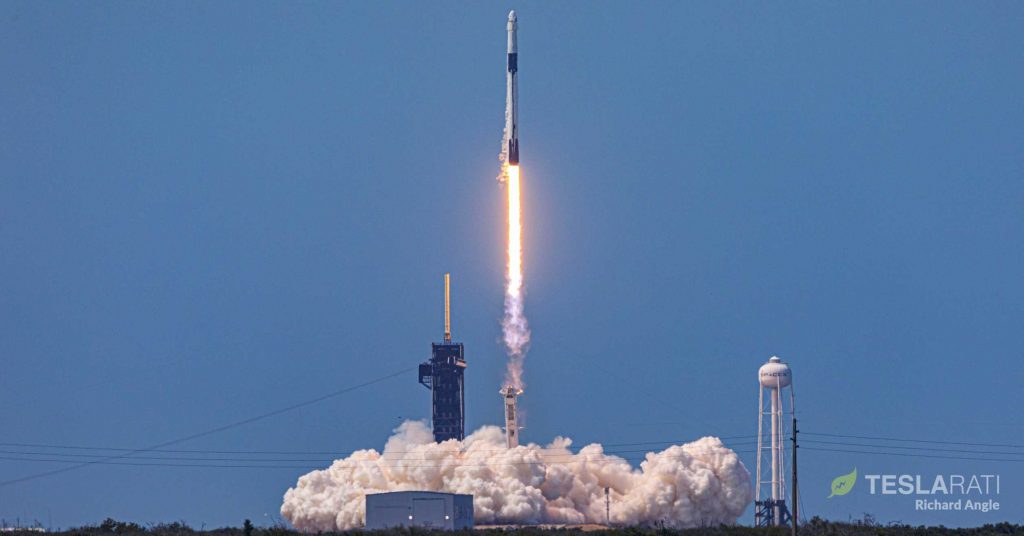

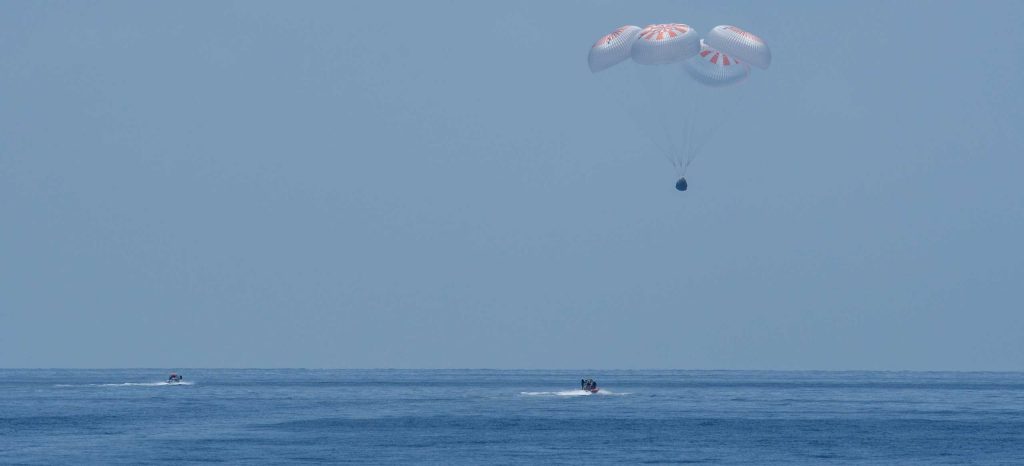
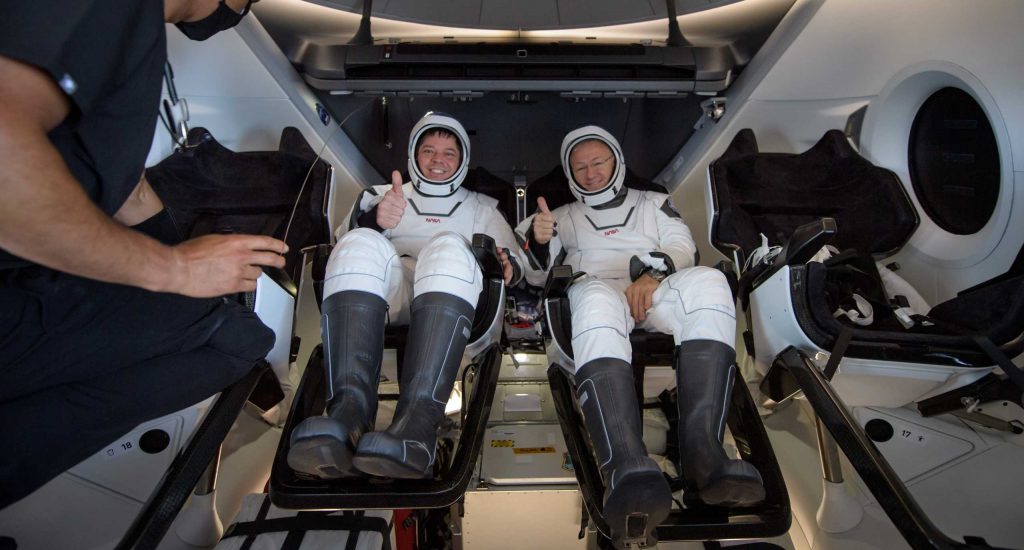
In 2018, Bob Behnken and Doug Hurley were assigned to SpaceX’s first crewed Crew Dragon test flight. Leaning on their histories as pilots and engineers, they worked with SpaceX for multiple years before the company’s historic astronaut launch debut. Their input lives on today throughout SpaceX’s Dragon program, from the spacecraft’s design and interior to how the company trains private and public astronauts.
On May 30th, 2020, Bob Behnken and Doug Hurley became the first NASA astronauts to lift off from US soil since the Space Shuttle’s 2011 retirement and the first astronauts in history to ride a privately-developed rocket and spacecraft into orbit. Defying expectations, Crew Dragon beat Boeing’s Starliner spacecraft to the punch and performed (more or less) flawlessly throughout its Demo-2 test flight.
NASA was so confident in SpaceX – and encouraged by Crew Dragon’s initial performance – that Demo-2 was extended from a minimum duration of about a week to 62 days. After two months in orbit, Crew Dragon successfully undocked from the International Space Station (ISS), deorbited, reentered Earth’s atmosphere, deployed parachutes, and gently splashed down in the Gulf of Mexico – safely returning Behnken and Hurley to Earth.
The highly successful test flight allowed NASA to rapidly certify Dragon. Less than four months later, another Crew Dragon spacecraft lifted on a Falcon 9 rocket on SpaceX’s first operational astronaut ferry mission for NASA. More than two years later, Boeing’s Starliner remains uncertified, and Crew Dragon is still the only spacecraft capable of sustaining the presence of NASA astronauts at the ISS. SpaceX is on track to launch its sixth consecutive astronaut ferry mission – Crew-6 – no earlier than February 26th.
The pressure on SpaceX and the importance of Crew Dragon to NASA cannot be overstated. In a nontrivial sense, NASA and SpaceX would not have Crew Dragon’s essential – and currently irreplaceable – capabilities without the work done and risks taken by Behnken and Hurley. Had either astronaut made a significant mistake or faltered during Dragon’s Demo-2 test flight, the state of US human spaceflight could be significantly worse off than it is today. Instead, the astronauts played their parts to perfection and helped catapult SpaceX, NASA, and the world into a new era of commercial human spaceflight.
Bob Behnken and Doug Hurley retired from NASA in 2021 and 2022, respectively. They will receive the 29th and 30th Congressional Space Medals of Honor.
Elon Musk
Tesla reveals it is using AI to make factories more sustainable: here’s how
Tesla is using AI in its Gigafactory Nevada factory to improve HVAC efficiency.

Tesla has revealed in its Extended Impact Report for 2024 that it is using Artificial Intelligence (AI) to enable its factories to be more sustainable. One example it used was its achievement of managing “the majority of the HVAC infrastructure at Gigafactory Nevada is now AI-controlled” last year.
In a commitment to becoming more efficient and making its production as eco-friendly as possible, Tesla has been working for years to find solutions to reduce energy consumption in its factories.
For example, in 2023, Tesla implemented optimization controls in the plastics and paint shops located at Gigafactory Texas, which increased the efficiency of natural gas consumption. Tesla plans to phase out natural gas use across its factories eventually, but for now, it prioritizes work to reduce emissions from that energy source specifically.
It also uses Hygrometric Control Logic for Air Handling Units at Giafactory Berlin, resulting in 17,000 MWh in energy savings each year. At Gigafactory Nevada, Tesla saves 9.5 GWh of energy through the use of N-Methylpyrrolidone refineries when extracting critical raw material.
Perhaps the most interesting way Tesla is conserving energy is through the use of AI at Gigafactory Nevada, as it describes its use of AI to reduce energy demand:
“In 2023, AI Control for HVAC was expanded from Nevada and Texas to now include our Berlin-Brandenburg and Fremont factories. AI Control policy enables HVAC systems within each factory to work together to process sensor data, model factory dynamics, and apply control actions that safely minimize the energy required to support production. In 2024, this system achieved two milestones: the majority of HVAC infrastructure at Gigafactory Nevada is now AI-controlled, reducing fan and thermal energy demand; and the AI algorithm was extended to manage entire chiller plants, creating a closed-loop control system that optimizes both chilled water consumption and the energy required for its generation, all while maintaining factory conditions.”
Tesla utilizes AI Control “primarily on systems that heat or cool critical factory production spaces and equipment.” AI Control communicates with the preexisting standard control logic of each system, and any issues can be resolved by quickly reverting back to standard control. There were none in 2024.
Tesla says that it is utilizing AI to drive impact at its factories, and it has proven to be a valuable tool in reducing energy consumption at one of its facilities.
Elon Musk
Tesla analysts believe Musk and Trump feud will pass
Tesla CEO Elon Musk and U.S. President Donald Trump’s feud shall pass, several bulls say.

Tesla analysts are breaking down the current feud between CEO Elon Musk and U.S. President Donald Trump, as the two continue to disagree on the “Big Beautiful Bill” and its impact on the country’s national debt.
Musk, who headed the Department of Government Efficiency (DOGE) under the Trump Administration, left his post in May. Soon thereafter, he and President Trump entered a very public and verbal disagreement, where things turned sour. They reconciled to an extent, and things seemed to be in the past.
However, the second disagreement between the two started on Monday, as Musk continued to push back on the “Big Beautiful Bill” that the Trump administration is attempting to sign into law. It would, by Musk’s estimation, increase spending and reverse the work DOGE did to trim the deficit.
Every member of Congress who campaigned on reducing government spending and then immediately voted for the biggest debt increase in history should hang their head in shame!
And they will lose their primary next year if it is the last thing I do on this Earth.
— Elon Musk (@elonmusk) June 30, 2025
President Trump has hinted that DOGE could be “the monster” that “eats Elon,” threatening to end the subsidies that SpaceX and Tesla receive. Musk has not been opposed to ending government subsidies for companies, including his own, as long as they are all abolished.
How Tesla could benefit from the ‘Big Beautiful Bill’ that axes EV subsidies
Despite this contentious back-and-forth between the two, analysts are sharing their opinions now, and a few of the more bullish Tesla observers are convinced that this feud will pass, Trump and Musk will resolve their differences as they have before, and things will return to normal.
ARK Invest’s Cathie Wood said this morning that the feud between Musk and Trump is another example of “this too shall pass:”
BREAKING: CATHIE WOOD SAYS — ELON AND TRUMP FEUD “WILL PASS” 👀 $TSLA
She remains bullish ! pic.twitter.com/w5rW2gfCkx
— TheSonOfWalkley (@TheSonOfWalkley) July 1, 2025
Additionally, Wedbush’s Dan Ives, in a note to investors this morning, said that the situation “will settle:”
“We believe this situation will settle and at the end of the day Musk needs Trump and Trump needs Musk given the AI Arms Race going on between the US and China. The jabs between Musk and Trump will continue as the Budget rolls through Congress but Tesla investors want Musk to focus on driving Tesla and stop this political angle…which has turned into a life of its own in a roller coaster ride since the November elections.”
Tesla shares are down about 5 percent at 3:10 p.m. on the East Coast.
Elon Musk
Tesla scrambles after Musk sidekick exit, CEO takes over sales
Tesla CEO Elon Musk is reportedly overseeing sales in North America and Europe, Bloomberg reports.

Tesla scrambled its executives around following the exit of CEO Elon Musk’s sidekick last week, Omead Afshar. Afshar was relieved of his duties as Head of Sales for both North America and Europe.
Bloomberg is reporting that Musk is now overseeing both regions for sales, according to sources familiar with the matter. Afshar left the company last week, likely due to slow sales in both markets, ending a seven-year term with the electric automaker.
Tesla’s Omead Afshar, known as Elon Musk’s right-hand man, leaves company: reports
Afshar was promoted to the role late last year as Musk was becoming more involved in the road to the White House with President Donald Trump.
Afshar, whose LinkedIn account stated he was working within the “Office of the CEO,” was known as Musk’s right-hand man for years.
Additionally, Tom Zhu, currently the Senior Vice President of Automotive at Tesla, will oversee sales in Asia, according to the report.
It is a scramble by Tesla to get the company’s proven executives over the pain points the automaker has found halfway through the year. Sales are looking to be close to the 1.8 million vehicles the company delivered in both of the past two years.
Tesla is pivoting to pay more attention to the struggling automotive sales that it has felt over the past six months. Although it is still performing well and is the best-selling EV maker by a long way, it is struggling to find growth despite redesigning its vehicles and launching new tech and improvements within them.
The company is also looking to focus more on its deployment of autonomous tech, especially as it recently launched its Robotaxi platform in Austin just over a week ago.
However, while this is the long-term catalyst for Tesla, sales still need some work, and it appears the company’s strategy is to put its biggest guns on its biggest problems.
-

 Elon Musk1 day ago
Elon Musk1 day agoTesla investors will be shocked by Jim Cramer’s latest assessment
-

 News6 days ago
News6 days agoTesla Robotaxi’s biggest challenge seems to be this one thing
-

 News2 weeks ago
News2 weeks agoTesla’s Grok integration will be more realistic with this cool feature
-

 Elon Musk2 weeks ago
Elon Musk2 weeks agoElon Musk slams Bloomberg’s shocking xAI cash burn claims
-

 News2 weeks ago
News2 weeks agoTesla China roars back with highest vehicle registrations this Q2 so far
-

 News2 weeks ago
News2 weeks agoTexas lawmakers urge Tesla to delay Austin robotaxi launch to September
-

 News2 weeks ago
News2 weeks agoTesla dominates Cars.com’s Made in America Index with clean sweep
-

 Elon Musk1 week ago
Elon Musk1 week agoFirst Look at Tesla’s Robotaxi App: features, design, and more




















